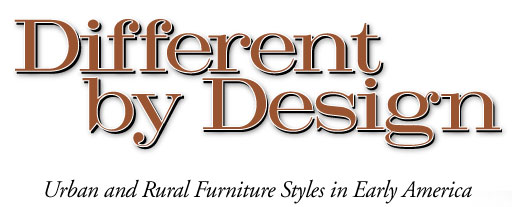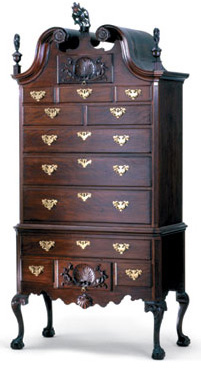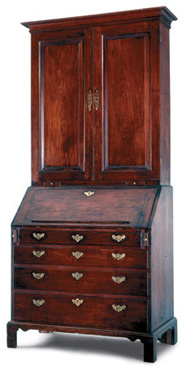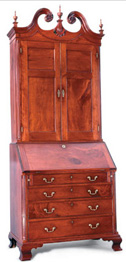 |
 |
|
by Tara Gleason Chicirda
|
|
 |
|
|
|
Fig. 1: High chest of drawers signed by Henry Cliffton and Thomas Carteret, Philadelphia, Penn., 1753. Mahogany, tulip poplar, maple, and brass. 1975–154. |
“The height of style.” “In the neatest taste.” “The most popular fashion.” All of these phrases have been used in preceding periods to describe fashionable furniture. Yet pieces that were considered stylish in one location were not always in vogue in another. During the mid- to late-eighteenth century, for example, the neat and plain style was fashionable in Norfolk and Williamsburg, while the flamboyant rococo style was popular in Philadelphia. Though large urban centers were the trendsetters for their regions, frontier communities of the eighteenth and early nineteenth centuries were distanced from the direct influence of urban fashions, and the newest styles and designs did not directly translate to outlying areas.
Included among these inland regions, referred to as the American backcountry, were the Valley of Virginia—a mountainous region ranging from Pennsylvania to North Carolina—and the Connecticut River Valley, an expanse that followed the river from Vermont through New Hampshire, Massachusetts, and into Connecticut. Immigrants of German, Swiss, French, English, Irish, Welsh, Scotch-Irish, and Scottish descent inhabited these regions, and brought with them various social, religious, political, and crafts traditions that often differed from those in the cities.
|
 |
|
|
|
| Fig. 2: Desk and bookcase signed by Mardun Vaughan Eventon,1 King William County, VA., 1750–1760. Descended in the Gwathmey family of the Burlington plantation in King William County, about twenty-five miles northwest of Williamsburg. Black walnut, yellow pine, oak, and brass. 1988–437. Gift of the Burlington-Gwathmey Memorial Foundation. |
|
American backcountry furniture at times emulated and at times diverged from the fashions popular in urban style centers. The isolation of some locales allowed the settlers to retain their cultural traditions as exemplified in the forms, styles, and decoration of their furniture. Yet many of the inhabitants looked to their coastal trading partners for the latest fashions and tried to emulate those styles, copying published designs or examples carried into the backcountry. As a result, backcountry furniture is as varied and individualistic as the inhabitants of the regions themselves.
The following series of comparisons demonstrates how American backcountry furniture makers were inspired by and also diverged from the forms, decoration, and style of their larger urban trading partners.
At the time the naturalistic rococo style was popular in the city of Philadelphia (Fig. 1), the clean lines of the neat and plain style (Fig. 2) were fashionable in eastern Virginia. The maker of the Winchester, Virginia, desk and bookcase (Fig. 3) combined elements of both styles. He introduced the broken-scroll pediment and carved motifs characteristic of the Philadelphia rococo, but reduced their abundance and complexity, incorporating the simplicity of the British style favored by Virginians; the resulting piece demonstrates a distinct regional design.
This melding of stylistic preferences is explained by Winchester’s location. Situated at the northern end of the Valley of Virginia, it was a cosmopolitan backcountry center founded on the site of a former Native American village that connected the north-south axis of the valley—through Ashby’s Gap—and the western frontier, by way of the Potomac River, with eastern Virginia.
|
|
 |
|
|
|
Fig. 3: Desk and bookcase, Winchester, VA., ca. 1795. Descended in the Lupton family of Frederick County, VA. Quakers from Pennsylvania, the Lupton family built a large brick house in 1794 for which this desk and bookcase and two related high chests may have been made in the succeeding year.2 Cherry, yellow pine, and brass. 1930–68. |
As a crossroads, Winchester’s fashions were greatly influenced by the divergent cultures and traditions of its inhabitants and of its trading partners in Philadelphia and eastern Virginia. The result was a stylistic amalgam of these areas.
Many of the settlers in the Valley of Virginia continued to use the same craft traditions and produce the same furniture forms as their European forebearers.
The tall clocks shown here (Figs. 4–5) represent two of the cultural groups present in the region. The Winchester clock (Fig. 4) is typical of a Pennsylvania clock of the late eighteenth century made in the British tradition. The Strasburg example (Fig. 5), produced twenty miles south of Winchester, expresses a Continental taste with its bombé base, arched hood, and glass lunette in the case door; all characteristics of a German baroque aesthetic. Though stylistically quite different, each original owner would have considered his clock to be fashionable.
Despite its appearance, the Winchester clock actually shares a Germanic construction feature with the Strasburg example. While most English and American clock cases were made in two pieces—the hood that frames the clock face, and a one-piece waist and base— both of these cases were made in three separate pieces, with a break between the waist and the base. Perhaps the maker of the Winchester clock had received his training from a Germanic cabinetmaker and thus perpetuated this feature while producing work for a patron who wanted a clock modeled on British design. |
|
 |
|
|
|
Fig. 4 (left): Tall clock, attributed to Winchester, VA., 1790–1800. Maple, yellow pine, black walnut, iron, steel, and brass. 1993–9.
|
|
|
 |
|
|
|
Fig. 5: (right): Tall clock, attributed to Thomas Jones, Strasburg, VA., 1790–1800. Black walnut, light and
dark wood inlay, iron, steel, and brass. 2002–69. |
British pattern books, popular with American cabinetmakers in urban areas, also found their way into the hands of backcountry craftsmen. Plate 76 in George Hepplewhite’s The Cabinet-Maker and Upholsterer’s Guide (1794), for instance, influenced the design of the backcountry chests in figures 6 and 7. Though the former follows Hepplewhite’s lines rather closely, its connection with the backcountry is revealed in the choice of cherry as a wood rather than the more expensive imported mahogany used in many urban chests of the period. Even so, because of its similarity to the popular published source, the cherry c
hest in figure 6 would have been considered as stylish along the coast as in western Massachusetts.
In 1825, thirty-one years after the publication of Plate 76, Thomas Matteson, an ornamental painter in Shaftsbury, Vermont, made a chest (Fig. 7) that followed the basic format of the Hepplewhite pattern. Rather than using the published design as a source, he most likely referenced a chest similar to the one in figure 6. His adaptation of the form included a flat rather than a more technically challenging bowed façade, and rather than using a hardwood such as cherry or mahogany, he imitated the grain of the wood with paint. Instead of the more time-consuming task of inlaying corner fans and stringing around the drawer fronts, he painted them in place. Matteson even used the outdated Hepplewhite design to conceal a less fashionable (but convenient) case form: the chest over drawers, in which the upper drawer fronts are false and the top lifts to reveal an inner compartment. Despite being outmoded, this painted chest filled a niche in the backcountry, where some fashions persisted longer than in the cities.
The exhibition Different by Design: Furniture Styles in Early America will be on view at Colonial Williamsburg’s DeWitt Wallace Decorative Arts Museum until November 2004. For information, call 757.220.7707, or visit www.ColonialWilliamsburg.org.
|
|
 |
|
|
|
Fig. 6: Chest of drawers, Connecticut River Valley, Mass., 1809. Cherry, white pine, whitewood inlays, and brass. 2001–821.
|
|
|

|
|
|
|
Fig. 7: Chest over two drawers, attributed to ornamental painter Thomas Matteson, Shaftsbury, Vermont, ca. 1825. Tulip poplar, basswood, paint, and brass. 2001–822. |
|
Tara Gleason Chicirda is Associate Curator of Furniture at Colonial Williamsburg Foundation, Williamsburg, Virginia.
1 For more information on Mardun Eventon and his
work see Ronald L. Hurst and Jonathan Prown, Southern Furniture 1680-1830: The Colonial Williamsburg Collection (New York: Harry N. Abrams, Inc., 1997), 462–466.
2 Ibid., 376–382.
3 Ibid., 562–566.
|
|
|